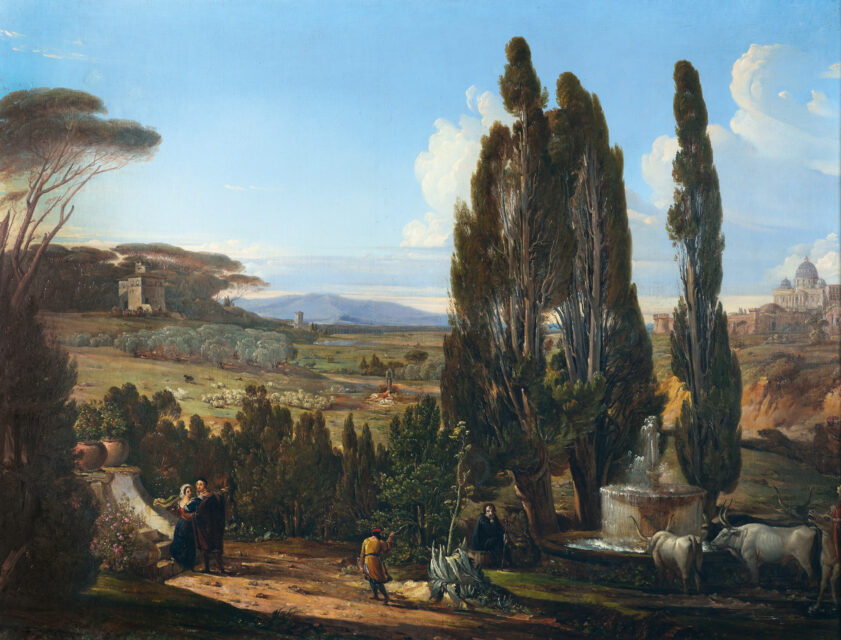Roman Campagna landscape with the Villa of Raphael
Details
Literatur:
Ulrike Eichler, “Raffaels Villa bei Rom. Gedanken zu einem Gemälde von Franz Nadorp”, in: Weltkunst, München 1979, Heft 12, S. 1566f., mit Abb.
Ausstellung:
Akademie-Ausstellung, Berlin, 1850, Nr. 1248.
Provenienz:
Leopoldine von Thun-Hohenstein, wohl direkt beim Künstler in Rom erworben;
Sammlung der Grafen von Thun-Hohenstein, Schloss Kwassitz, Mähren, bis zum 2. Weltkrieg;
Neumeister, München, Auktion, 28.6.1979, Los 1496;
Privatbesitz, Süddeutschland.
Description
In 1850, the painter Franz Nadorp, who lived in Rome, presented our painting, which superficially shows a Roman landscape with a view of the Campagna, to the Academy exhibition in Berlin. The view, partly obscured by mighty pine trees, extends to the right of St Peter’s across the Tiber plain, where a flock of sheep is grazing, to a hill with umbrella pines. In front of the pines is an inconspicuous, simple building, which is nevertheless one of the most frequently reproduced buildings in Rome in the first half of the 19th century – it is the legendary Casina di Raffaello, supposedly the country house of the “Divine” on the Pincio, where, according to legend, he recovered from his labours in the arms of his lover Fornarina. In Raphael’s alleged garden house, there were frescoes with love allegories executed by pupils of Raphael after drawings by the master – giving rise to the misconception that the building was Raphael’s own villa.
Nadorp, who had come to Rome in 1828 and was active in the German artists’ association there as an organiser of various festivities, had joined the circle of Nazarenes around Friedrich Overbeck and Peter von Cornelius, who had chosen Raphael’s painting as a model of religious piety and grace. Rome was gripped by a true Raphael enthusiasm in the years after 1810, which also infected Nadorp, who had already visited and sketched the garden house immediately after his arrival. His painting is also an expression of this admiration for Raphael, in which Raphael embraces his lover in the foreground on the park steps, but pauses to look backwards, where an artist – carrying a portfolio under his arm – points to the cypresses on the right. There, a farmer has led his cattle to the watering trough, but in their shade sits Michelangelo Buonarotti, all in black, lost in melancholy. “Raphael’s Villa near Rome – in the foreground left Raphael and the Fornarina, on the right Michelangelo under cypresses” reads the contemporary label on the stretcher. For his portraits of Raphael, the Fornarina and Michelangelo, Nadorp orientated himself on historical portraits – such as Raphael’s self-portrait from the School of Athens, his portrait of the Fornarina in the Barberini Collection in Rome and, for Michelangelo, Jacopo del Conte’s portrait in the Uffizi, while the young artist with the portfolio is probably Nadorp himself. His painting thus becomes not only an impressive testimony to the Raphael cult in the 19th century, but also a personal reflection on his own artistic path: like Hercules at the crossroads, he stands between the two artists, striding towards Raphael and yet pointing back to the older Michelangelo. The art-theoretical discourse in the early 19th century oscillated between these two “forefathers” of art, but if we consider Nadorp’s career, who emerged as a copyist after Raphael at the Prague Academy of Art and was later close friends with Nazarenes in Rome who paid homage to Raphael, then his painting is a confession to Raphael.
In 1850, however, when Nadorp exhibited his painting, this avowal was merely a romantic reminiscence that had been overtaken by reality – in 1849, French troops had fired on Rome and destroyed the Casina di Raffaello in the process. However, Nadorp was able to access a larger version of his painting, painted in 1843, which was in the possession of the Prussian king (today Potsdam, Sanssouci Palace, Orangery).
Dr Peter Prange
* All results incl. buyer’s premium (27%) without VAT. No guarantee, subject to error.
** All post-auction prices excl. buyer's premium and VAT. No guarantee, subject to error.
*** Conditional Sale: The bid was accepted below the limit. Acquisition of the work may still be possible in our post-auction sale.
R = regular taxation
N = differential taxation on works of art which originate from a country outside of the EU
The private or commercial use of images shown on this Website, in particular through duplication or dissemination, is not permitted. All rights reserved.





